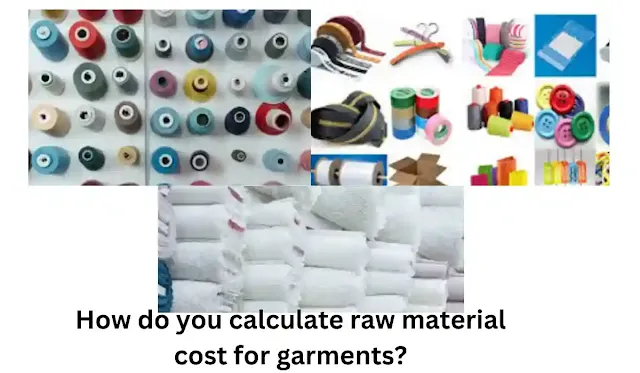How do you Calculate Raw Material Cost for Garments?
The Apparel Industry, Raw Material costs represent a significant portion of the total cost of producing a garment. Accurately calculating the raw material cost is essential for pricing, budgeting, and ensuring profitability.
Raw material cost refers to the expenses incurred for all the fabric, trims, and accessories used in the production of a garment. This includes the cost of fabric, buttons, zippers, threads, labels, and any other materials required to make the finished product.
Understanding and controlling raw material costs are crucial for ensuring that your garment pricing is competitive while maintaining profitability.
Key Components of Raw Material Cost
Fabric Cost
- Fabric is typically the most expensive raw material in garment production, making up 50-70% of the total cost. To calculate fabric cost, you need to consider the following factors:
- Fabric consumption per garment: Measured in meters or yards, this is the amount of fabric required for a single garment.
- Fabric price per unit: The cost of fabric per meter, yard, or kilogram.
Formula for fabric cost:
Trims and Accessories Cost
- Trims and accessories include zippers, buttons, labels, elastic, lining, and more. Each of these items has its own cost, which should be added to the total raw material cost.
Trims cost can be calculated based on the quantity required per garment multiplied by the unit price of each trim or accessory.
Formula for trims cost:
Trims Cost = ∑ ( Quantity of Trim × Price per Trim )
Thread Cost
- Thread cost can be determined by calculating the total amount of thread required per garment and the price per spool or meter. Though thread cost is usually small, it still contributes to the overall raw material cost.
Labels and Tags
- Labels (brand, size, care, etc.) and hang tags are essential components of any garment. The cost of each label and tag should be added to the raw material cost.
Packaging Materials
- If your garment requires special packaging materials such as polybags, cartons, or tissue paper, their costs should also be factored into the raw material cost.
Steps to Calculate Raw Material Cost for Garments
1. Calculate Fabric Consumption
Fabric consumption refers to the total amount of fabric required to produce one garment. It is measured in yards, meters, or kilograms, depending on the type of fabric and how it is purchased.
For example, to calculate the fabric consumption for a T-shirt:
- Front panel: 0.75 yards
- Back panel: 0.75 yards
- Sleeves: 0.3 yards
Total fabric consumption = 1.8 yards per garment.
2. Calculate Fabric Cost
Once fabric consumption is determined, multiply it by the cost of the fabric per yard or meter.
For example, if the fabric cost is $3 per yard:
3. Determine Trims and Accessories Cost
Next, calculate the cost of trims and accessories used in the garment. For example:
- Zipper: $0.50
- Buttons: $0.30
- Labels: $0.20
- Elastic: $0.10
The total trims and accessories cost would be:
4. Add Thread Cost
Estimate the cost of the thread required for stitching one garment. For example, if 0.10 USD worth of thread is used, this should be added to the cost.
5. Calculate Packaging Material Costs
Include the cost of any packaging materials like polybags or hang tags. For example, if the packaging materials cost $0.20 per garment, this should be added.
Final Raw Material Cost Calculation
Once you have calculated the fabric cost, trims, accessories, thread, and packaging costs, the final raw material cost can be determined using the following formula:
Example of Raw Material Cost Calculation
Let’s calculate the raw material cost for a basic T-shirt:
- Fabric consumption: 1.8 yardsFabric price: $3 per yard
- Trims and accessories cost: $1.10
- Thread cost: $0.10
- Packaging material cost: $0.20
Total Raw Material Cost:
The raw material cost for producing one T-shirt would be $6.80.
Importance of Raw Material Cost Calculation
Pricing Strategy
Calculating raw material costs allows manufacturers to determine the total cost of producing a garment, which is crucial for setting a competitive yet profitable selling price.Cost Control
By understanding the raw material cost, manufacturers can identify areas to reduce costs, negotiate better prices with suppliers, and avoid overpaying for materials.Budgeting and Forecasting
Accurate raw material cost calculations help in creating realistic budgets and production forecasts, ensuring the business runs smoothly and profitably.
Factors Affecting Raw Material Costs
Fabric Type and Quality
Different fabrics (cotton, polyester, silk, etc.) have varying costs based on their quality, weight, and source.Order Volume
The larger the order, the more room there is to negotiate lower prices for bulk fabric and trims.Supplier Relationships
Strong relationships with reliable suppliers can lead to better deals, faster delivery times, and consistent quality.Market Fluctuations
Raw material prices can fluctuate due to supply chain issues, political factors, and global demand.
Conclusion
Accurately calculating the raw material cost is essential for garment manufacturers to ensure profitable operations and competitive pricing. By understanding the costs of fabric, trims, accessories, and other components, manufacturers can effectively plan their production and pricing strategies.
This not only helps control costs but also ensures timely delivery of quality products to the market.




.png)
.png)



